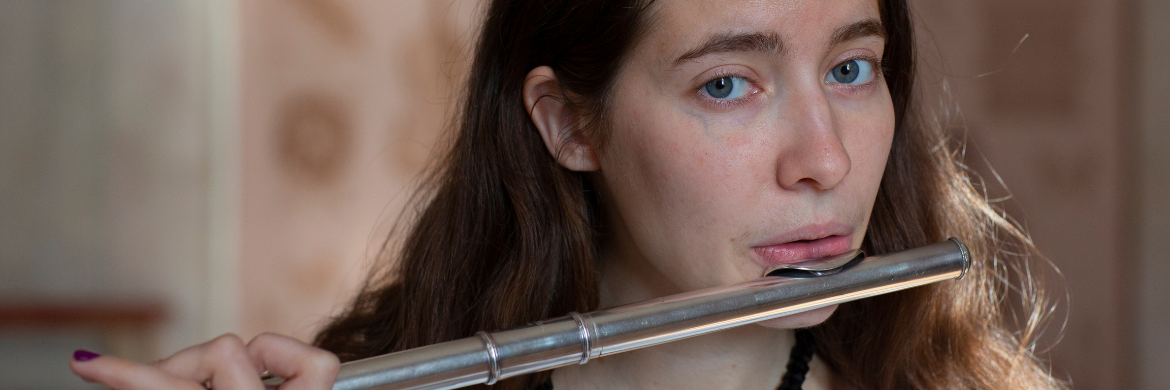
The term “embouchure dystonia” describes a type of dystonia that affects brass and woodwind players. The term embouchure refers to the adjustment of the mouth to fit the mouthpiece of a wind instrument. The anatomy of this form of dystonia includes muscles of the mouth, face, jaw, and tongue.
- Symptoms
The abnormal movements that characterize embouchure dystonia are often very subtle and occur only while the musician is playing, buzzing into the mouthpiece, or forming the embouchure. Most brass and woodwind players use a combination of puckering and smiling to play. At least twelve muscles are involved in positioning the mouth in this way, not including the equally complicated structure of the tongue and jaw. Pinpointing the most important muscles necessary for shaping the mouth to play a brass or woodwind instrument is difficult.
Symptoms of embouchure dystonia may include:
• Air leaks at the corners of the mouth: Sometimes worse in higher registers and accompanied by a noticeable tremor.
• Involuntary, abnormal contractions of the muscles in the face: Involuntary puckering; Excessive elevation of the corners of the mouth; Involuntary closing of the mouth.Some musicians’ difficulties are limited to sustained notes in particular registers or to certain passages at specific speeds. The dystonia is typically painless but may elicit intense psychological stress.
- Cause
There is no one isolated cause of embouchure dystonia, and the neurological origins are not entirely understood. As a child develops, he/she learns many different movements (such as walking, writing, or playing an instrument) that are stored in the brain as motor programs. Instances of embouchure dystonia that are highly task-specific have been described as a “computer virus” or “hard drive crash” in the sensory motor programs that are essential for playing music. However, additional factors, such as a genetic predisposition, are likely to play a significant role in the development of such a sensory-motor dysfunction. Why this “computer virus” cannot be easily overcome by establishing a new and improved sensory-movement pattern remains an important question for researchers.
- Treatment
The treatment of embouchure dystonia, like the treatment of all dystonias, is purely symptomatic at this stage. The following therapies may be attempted, but typically provide little relief for embouchure dystonia:
• Oral medications, including Artane® (trihexyphenidyl), Klonopin® (clonazepam), and Lioresal® (baclofen)
• Botulinum toxin injections, but the anatomy of the area must be carefully considered to avoid unacceptable oral weakness
- What Type of Doctor Treats Musician's Dystonia
The type of doctor that is typically trained to diagnose and treat dystonia is a neurologist with special training in movement disorders (movement disorder specialist). Select performing arts medicine specialists may also be qualified to identify and treat dystonia, depending on their training and experience.
- Living with Musician's Dystonia
Living well with dystonia is possible. Individuals affected by dystonia are strongly encouraged to:
• Seek evaluation from a neurologist with special training in movement disorders.
• Learn about dystonia and treatment options.
• Seek expert mental health professionals to diagnose and treat possible co-existing anxiety and/or depression.
• Develop a support system of support groups, online resources, friends, and family.
• Explore complementary therapies for overall wellness.
• Get active within the dystonia community.
- Leon Fleisher's Foundation for Musicians with Dystonia
Musicians With Dystonia was founded in 2000 by Glen Estrin, a former professional French horn player diagnosed with embouchure dystonia, and Steven Frucht, MD in partnership with the Dystonia Medical Research Foundation (DMRF). The program was renamed in 2020 to the Leon Fleisher Foundation For Musicians With Dystonia to honor the memory of Leon Fleisher.
The Foundation established a network of health care practitioners knowledgeable about the disorder and an informal support network of fellow affected musicians.
- Keith Emerson Fund & Tribute
Keith Emerson, legendary keyboardist and composer, best known as a founding member of the iconic supergroup Emerson, Lake & Palmer, was lesser known for his struggles with musician’s dystonia, which significantly impacted his ability to perform. Keith passed away in 2016, but his legacy as a performer lives on. His family and friends are honoring this legacy by supporting the DMRF in his memory. Learn more.
Plus, a new concert film and album documents the May 2016 tribute show in his honor. The Official Keith Emerson Tribute Concert is available as a four-disc set featuring DVD and two CDs capturing the entire two-and-a-half-hour event and a disc of bonus interviews. Click here for details and to order.
- Peer Support for Musicians
Musicians with Dystonia Support Forum is a private Facebook group where musicians affected by dystonia are welcome to connect, to give and get support.
Thank you to Dystonia Medical Research Foundation (USA) for allowing us to share this information. The DMRF is a 501(c)(3) non-profit organization dedicated to advancing research for improved dystonia treatments and ultimately a cure, promoting awareness, and supporting the well-being of affected individuals and families.
